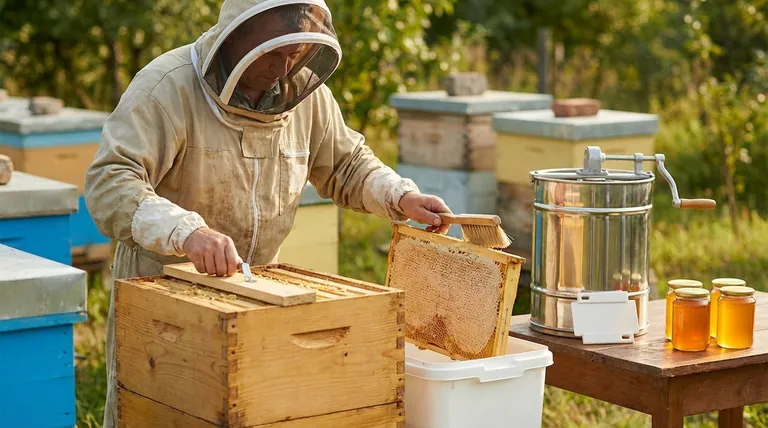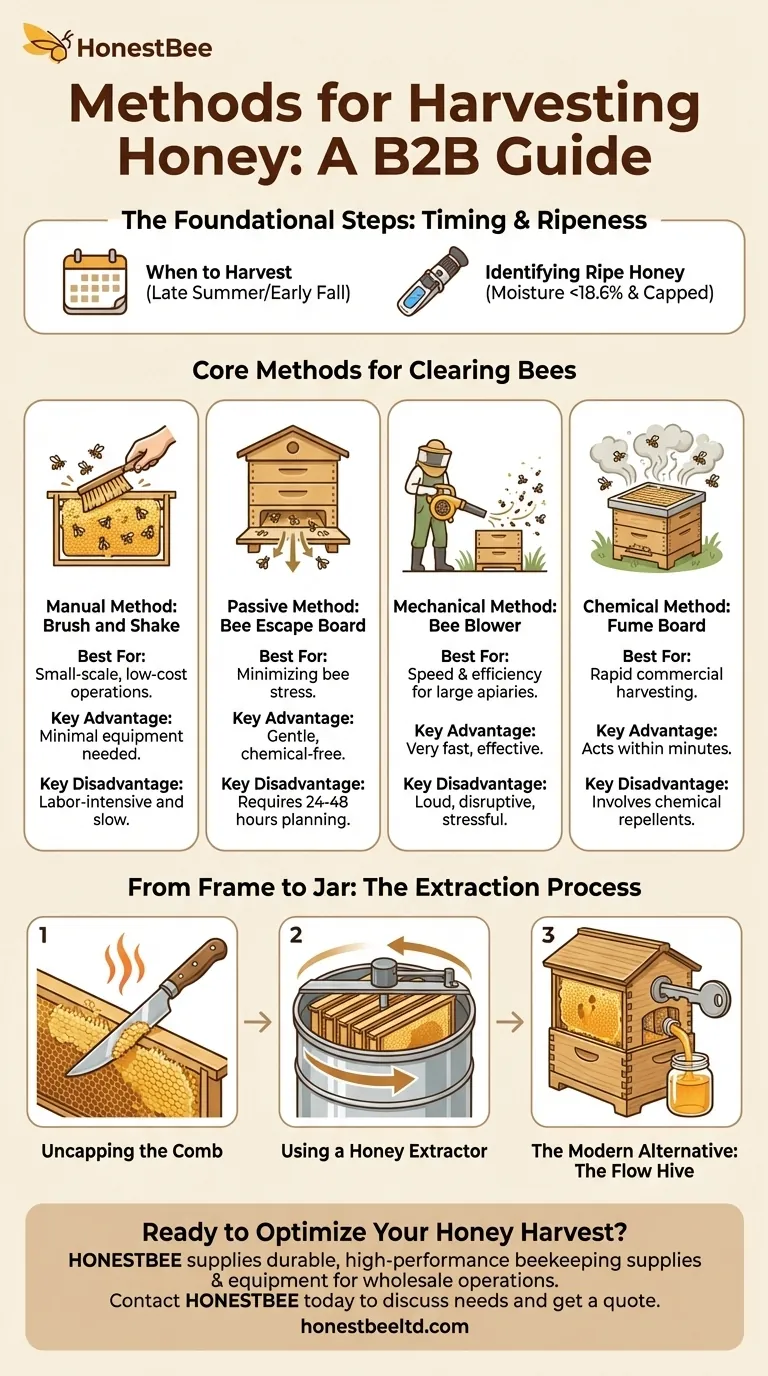To harvest honey, beekeepers must first remove bees from the frames of honey. The primary methods for this are manually brushing or shaking the bees off, using a one-way "bee escape board" to passively clear the frames, using a "bee blower" for rapid removal, or applying a chemical repellent on a "fume board" to drive bees away.
The core challenge of harvesting honey is not the extraction itself, but first separating the bees from their honey with minimal stress to the colony and maximum efficiency for the beekeeper. Your choice of method reflects a balance between your scale, philosophy, and equipment investment.

The Foundational Steps of Any Honey Harvest
Before you can choose a method, you must understand the two universal prerequisites for a successful and responsible harvest: timing and ripeness.
When to Harvest
The ideal time for harvesting is typically late summer or early fall, after the primary nectar flow has ended.
It's a delicate balance. You must ensure bees have enough space by not letting the hive become overly full, but it is critical to leave enough honey for the colony to survive the winter.
Identifying Ripe Honey
Honey is "ripe" when its moisture content is low enough (typically below 18.6%) to prevent fermentation. Bees signal this by capping the honeycomb cells with a layer of white wax.
For a more precise measurement, beekeepers use a tool called a refractometer to verify the exact moisture content before harvesting.
Core Methods for Clearing Bees from Frames
Once you've confirmed your honey is ready, you must clear the bees from the honey "supers" (the boxes holding the honey frames). This is where the primary methods diverge.
The Manual Method: Brush and Shake
This is the most straightforward approach. Frames are removed from the super one by one, and bees are gently dislodged with a soft bee brush or a firm shake.
This method requires no special equipment beyond a brush but can be slow and labor-intensive, making it best suited for beekeepers with only one or two hives.
The Passive Method: Bee Escape Board
A bee escape board is a chemical-free, low-stress option. This board, containing a one-way passage, is placed between the honey supers and the lower brood chambers.
Over 24-48 hours, bees travel down into the brood box but cannot return to the super. This method is very gentle on the bees but requires planning ahead.
The Mechanical Method: Bee Blower
A bee blower is essentially a low-powered leaf blower. It uses a high volume of air to quickly force bees off the frames and out of the super.
This is a fast and effective method favored by commercial beekeepers, but it is loud, disruptive, and can be stressful for the colony.
The Chemical Method: Fume Board
A fume board has an absorbent inner lining onto which a non-toxic chemical repellent is sprayed. The board is placed on top of the open honey super.
The fumes, which are heavier than air, sink down and drive the bees out of the super, usually within minutes. This method is fast but involves chemicals that some beekeepers prefer to avoid.
From Frame to Jar: The Extraction Process
After the frames are free of bees, you must extract the honey.
Uncapping the Comb
The wax cappings that seal the honey cells must be removed. This is typically done with a heated uncapping knife or a specialized fork that scrapes the cappings off.
Using a Honey Extractor
The uncapped frames are placed inside a honey extractor. This device uses centrifugal force to spin the honey out of the comb without destroying it.
After spinning both sides of the frames, the now-empty "wet" frames can be returned to the bees to clean and reuse.
The Modern Alternative: The Flow Hive
The Flow Hive is a specific type of beehive designed to eliminate the need for traditional extraction.
Beekeepers turn a key that splits the honey cells within a specialized frame, allowing the honey to flow directly out of the hive and into a jar, causing minimal disturbance to the bees.
Understanding the Trade-offs
Each harvesting method presents a different set of advantages and disadvantages. Your choice depends on what you prioritize.
Stress on the Bees
The bee escape board is by far the gentlest method. Manual brushing is also low-stress if done carefully. In contrast, bee blowers and fume boards are fast but far more disruptive to the colony.
Beekeeper Effort and Speed
Bee blowers and fume boards are the fastest methods, making them ideal for large-scale operations. The brush-and-shake method is the most labor-intensive, while the escape board requires minimal active work but a longer waiting period.
Equipment and Cost
The brush-and-shake method requires the least specialized equipment. Extractors represent a significant investment but are essential for traditional large harvests. The Flow Hive has a high upfront cost but simplifies the process dramatically.
Making the Right Choice for Your Apiary
To select the best method, align your approach with your primary goal as a beekeeper.
- If your primary focus is simplicity with only 1-2 hives: The brush-and-shake method combined with traditional extraction is the most direct, lowest-cost starting point.
- If your primary focus is minimizing bee stress: The bee escape board is the ideal choice, as it clears the honey supers gently over time.
- If your primary focus is speed and efficiency for many hives: A bee blower or fume board will clear supers rapidly, maximizing what you can accomplish in a day.
- If your primary focus is convenience and minimal disruption: The Flow Hive system is designed specifically to make harvesting a simple, non-invasive task.
Ultimately, a successful harvest respects the bees while meeting the goals of the beekeeper.
Summary Table:
| Method | Best For | Key Advantage | Key Disadvantage |
|---|---|---|---|
| Brush and Shake | Small-scale, low-cost operations | Minimal equipment needed | Labor-intensive and slow |
| Bee Escape Board | Minimizing bee stress | Gentle, chemical-free | Requires 24-48 hours of planning |
| Bee Blower | Speed and efficiency for large apiaries | Very fast, effective for many hives | Loud, disruptive, and stressful for bees |
| Fume Board | Rapid commercial harvesting | Acts within minutes | Involves chemical repellents |
| Flow Hive | Ultimate convenience and minimal disruption | Honey flows directly into jars; no extraction needed | High upfront cost for the specialized hive system |
Ready to Optimize Your Honey Harvest?
Whether you're a commercial apiary managing hundreds of hives or a distributor supplying beekeeping equipment, the right tools make all the difference. HONESTBEE supplies the durable, high-performance beekeeping supplies and equipment you need—from bee brushes and escape boards to commercial-grade extractors—through our wholesale-focused operations.
Let us help you achieve a more efficient, productive, and bee-friendly harvest.
Contact HONESTBEE today to discuss your specific needs and get a quote on our wholesale supplies.
Visual Guide

Related Products
- Professional Wide Blade Honey Scraper for Beekeeping and Honey Processing
- Professional Extra-Wide Uncapping Fork with Bent Tines for Beekeeping
- Professional Long-Handled Silicone Honey Scraper for Beekeeping
- Professional Dual-End Stainless Steel Hive Tool for Beekeeping
- Portable Uncapping Tank Holder Uncapping Bench for Beekeeping
People Also Ask
- What equipment do you need to make honey? A Complete Guide to Starting Your Apiary
- Can I extract uncapped honey? Avoid spoilage by trusting the bees' quality control.
- What other tools are available for honey uncapping besides knives? Find the Right Tool for Your Apiary's Scale
- How can a capping scratcher be used with an electric knife? Boost Efficiency and Honey Yield
- Why is my honey frame not capped? Your Guide to Perfectly Ripe Honey



















